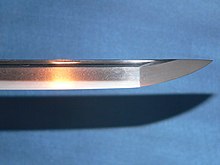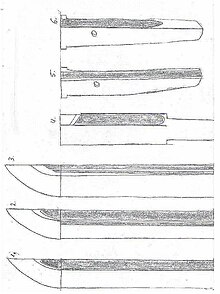Hi (blade)
The Hi ( Jap. 樋 ) is the groove on Japanese blade. In combination with other characters, a sound change to Bi can take place.
description
The hi is engraved or forged on the blades. They can be traced back to the oldest sword blades. The Hi serves to reduce the weight of the blade without reducing its strength and without improving the cutting properties. Another reason is to improve the balance of the blade or restore it after a cut. In this case the Hi is referred to as Ato-Bi ( 後 樋 , “later Hi”). There are nine different forms of hi which are named as follows:
- Bō-hi ( 棒 樋 , "dash-hi"). A long, straight and wide throat. When attached to a tanto , it is called katana-hi .
- Bō-hi with Soe-bi ( 添 樋 , "added hi"): A wide throat with a second, narrower throat.
- Futasuji-bi ( 二 筋 樋 ): Two parallel throats.
- Naginata-hi ( 薙刀 樋 ): A small Bō-hi , with a front end that is worked the other way around like the katana-hi . The beginning begins round and often also has a Soe-hi . This version of the Hi is often seen on blades from Naginata or on Wakizashi and on Tantō , which are forged in the Kanmuri-otoshi-zukuri style.
- Kaki-tōshi (hi) ( 掻 き 通 し (樋) , "all through Hi"): The throat runs the entire length of the blade and ends on the nakago .
- Kaki-nagashi (hi) ( 掻 き 流 し (樋) , "widening Hi"): The beginning of the throat is round. It ends at about half the blade.
- Kaku-dome ( 角 留 , "square stop"): This type ends about 3 cm in front of the machi (beginning of the nakago ).
- Maru-dome ( 丸 留 , "round stop"): This type also ends about 3 cm in front of the machi, but has a rounded end.
Not shown is the:
- Kuichigai-bi ( 喰 違 樋 ): Two narrow throats run across half of the blade. The upper throat (towards the back) ends while the lower one continues and goes around the shorter one.
There is another distinction for the hi , which is incorporated into a blade of the Shinogi-zukuri type : If there is a very narrow Shinogi (ridge line) on the throat , it is called a chiri ( 散 , "wall of the throat"). If there is a very narrow shinogi on the mune side of the throat, this type is called kata-chiri ( 片 散 , "a wall") - Figure 9. If there is a shinogi on either side of the hi , it is called a ryo -chiri ("two walls";).
Individual evidence
- ↑ a b Tamio Tsuchiko: The New Generation of Japanese Swordsmiths. Translated by Kenji Mishina. Kodansha International, Tokyo et al. 2002, ISBN 4-7700-2854-7 , pp. 31-32.
- ↑ probably 両 散
literature
- Kōkan Nagayama: The Connoisseur's Book of Japanese Swords. Kodansha International, Tokyo 1998, ISBN 4-7700-2071-6 .
- Nobuo Ogasawara: Japanese swords . 12th edition. Hoikusha, Osaka 1993, ISBN 4-586-54022-2 ( Color Books 22).
- John M. Yumoto: The Samurai Sword. A handbook . Tuttle Publishing, Rutland VT et al. 1988, ISBN 0-8048-0509-1 .


